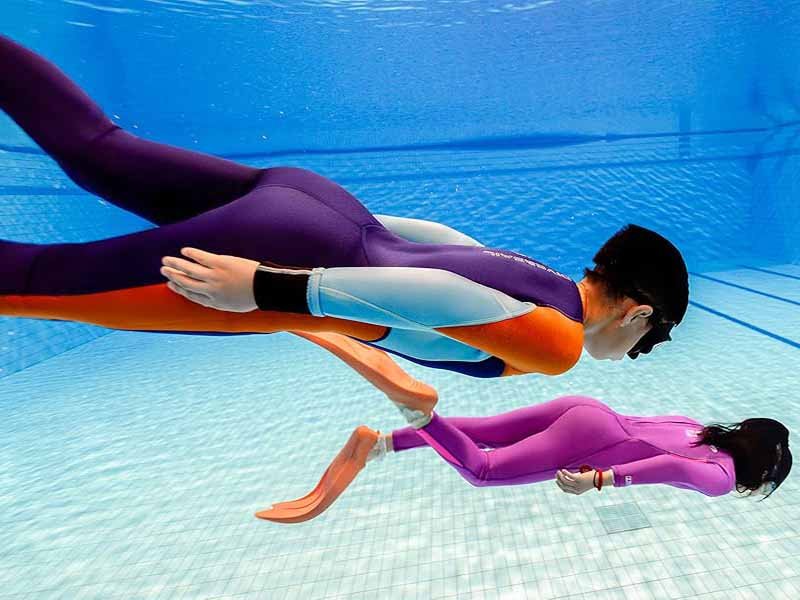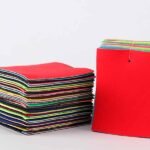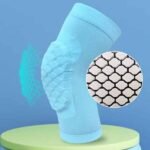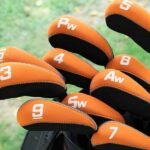Parents love seeing their kids play fearlessly in the water — whether it’s swimming lessons, surfing at the beach, or exploring a lake during vacation. But here’s the challenge: children lose body heat up to four times faster than adults, and the water that feels “fresh” to you can feel freezing to them within minutes. That’s why kids’ wetsuits exist — not just as sportswear, but as safety gear that helps them stay warm, buoyant, and confident.
If you’ve ever wondered what makes these miniature wetsuits so effective, the answer lies in the material — neoprene. It’s the same flexible, insulating fabric used in professional diving and surfing suits, but designed for comfort and freedom of movement in young swimmers.
A kids’ wetsuit is a flexible, insulated suit made from neoprene that helps children stay warm, comfortable, and buoyant in water. It traps a thin layer of water between the skin and suit, which warms up and prevents heat loss. Wetsuits also protect kids from UV rays, abrasions, and jellyfish stings. Available in various thicknesses (2mm–5mm), they are essential for swimming, surfing, diving, and other water sports.
Imagine this: a family at the beach on a breezy morning. The kids rush into the waves, squealing with excitement. Within ten minutes, one child starts shivering, while another — wearing a bright blue neoprene wetsuit — keeps swimming happily, laughing at the surf. That simple difference isn’t about bravery. It’s about body temperature control, buoyancy, and freedom to move — exactly what a wetsuit provides.
In this guide, we’ll dive deep into how kids’ wetsuits work, which material performs best, how to choose the right thickness and fit, and why custom neoprene wetsuits from manufacturers like Szoneier are trusted worldwide by parents, swim schools, and outdoor brands.
What Is a Wetsuit for Kids and How Does It Work?

A kids’ wetsuit is a snug-fitting garment made from neoprene that insulates the body and helps children stay warm in water. It traps a thin layer of water between the suit and skin, which quickly warms to body temperature. The neoprene’s closed-cell foam structure provides buoyancy, flexibility, and protection from cold, UV, and abrasions — making it perfect for swimming, surfing, and water play in cooler conditions.
1. The Thermal Principle — How Neoprene Keeps Kids Warm
Wetsuits don’t keep water out; instead, they use water to your advantage. When a child enters the water, a thin layer seeps inside the suit. This layer is trapped between the neoprene and skin. The child’s body heat warms this water, creating a thermal barrier that reduces further heat loss.
Neoprene — the key material — is filled with millions of microscopic closed air cells. These cells act as insulation, slowing down heat transfer from the body to the surrounding water. The thicker the neoprene, the better the insulation — but thicker also means slightly less flexibility, so finding the right balance is crucial.
2. Buoyancy and Safety
Neoprene not only keeps kids warm — it helps them float. The trapped air in the neoprene adds natural buoyancy, making it easier for children to stay on the surface while learning to swim.
This is especially helpful for:
- Kids still building confidence in the water.
- Parents who want added safety without bulky life jackets.
- Swim schools training young beginners.
A well-fitted wetsuit won’t replace a flotation device but provides assisted buoyancy that helps kids move comfortably and safely.
3. UV and Skin Protection
A quality wetsuit covers much of a child’s body, protecting against UV rays, wind chill, and surface abrasions from sand or surfboards. In tropical regions, thin 2mm “shorty” wetsuits often replace sunscreen for long sessions outdoors.
This protective layer also shields from:
- Jellyfish stings.
- Minor scratches.
- Cold winds during breaks between swims.
4. The Comfort Factor
Children’s wetsuits are designed with flexibility and softness in mind. Unlike rigid rubber or thick fabrics, neoprene stretches up to 200% of its original length, ensuring comfort while paddling, bending, or diving. Flatlock or blind-stitch seams prevent chafing, while adjustable zippers make dressing easy even for toddlers.
5. A Short History of Kids’ Wetsuits
Initially, wetsuits were exclusively for divers and surfers, but as water recreation became more family-oriented, manufacturers started creating kid-specific versions — thinner, softer, and easier to wear. Today, premium factories like Szoneier use advanced laminating and cutting technology to make wetsuits that balance insulation and mobility for every age group.
6. Typical Applications
| Use Case | Recommended Thickness | Notes |
|---|---|---|
| Indoor swimming lessons | 2mm shorty | Comfort + warmth |
| Beach play in mild weather | 2–3mm shorty | Easy to move in |
| Surfing or snorkeling | 3–4mm full suit | UV + cold water protection |
| Cold-water diving or long sessions | 5mm full suit | Maximum warmth |
Whether for swim classes or weekend surf trips, the wetsuit isn’t just an outfit — it’s protection, comfort, and confidence combined.
Do Kids Really Need Wetsuits for Swimming or Water Sports?
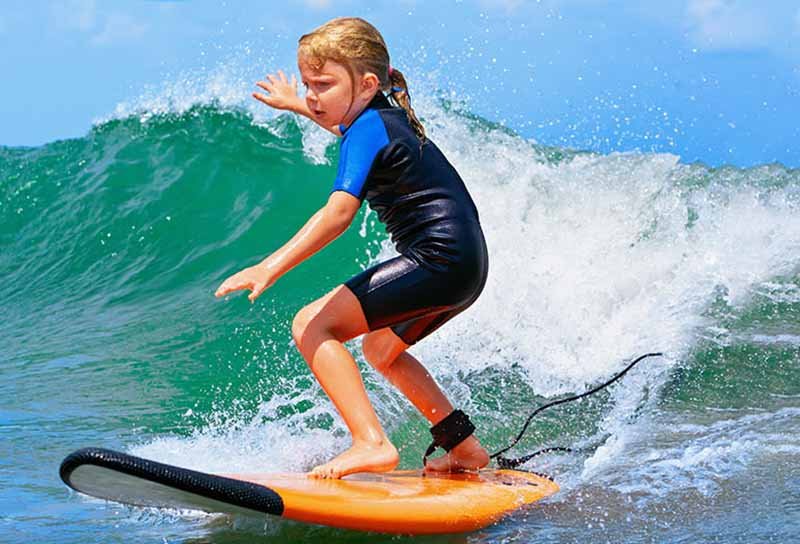
Kids need wetsuits for any water activity where temperatures fall below 77°F (25°C) or where they’ll spend long periods swimming or surfing. Wetsuits help maintain body warmth, improve buoyancy, and protect from UV rays, stings, and abrasions. Even in mild climates, they reduce fatigue and make water play safer and more enjoyable — especially for toddlers and young swimmers who lose body heat quickly.
1. Children Lose Heat Faster Than Adults
Kids’ bodies have a higher surface-area-to-mass ratio, meaning they lose heat up to four times faster than adults. A child who looks comfortable at first may start shivering within minutes — not because the water is “too cold,” but because their smaller bodies can’t retain warmth.
Neoprene wetsuits slow this process dramatically, giving parents peace of mind and kids longer, safer playtime in the water.
Many swimming coaches report that students wearing wetsuits stay focused longer and show better endurance during lessons — less distraction, more fun.
2. Not All Waters Are Warm
Even in tropical regions, morning or shaded waters can be surprisingly cool. Ocean currents, mountain lakes, or shaded pools can sap warmth quickly.
Here’s a useful temperature vs. wetsuit chart for kids:
| Water Temperature (°F/°C) | Recommended Wetsuit Type | Typical Thickness |
|---|---|---|
| 77°F+ / 25°C+ | Optional, shorty suit for UV protection | 1.5–2mm |
| 68–76°F / 20–24°C | Recommended for long swims | 2–3mm |
| 59–67°F / 15–19°C | Essential for comfort and safety | 3–4mm |
| Below 59°F / 15°C | Full wetsuit required | 5mm+ |
The goal isn’t over-insulation — it’s maintaining a natural, comfortable body temperature while swimming or surfing.
3. Water Sports Demand Extra Protection
Wetsuits aren’t only for “cold water.” They’re also protective gear for active sports:
- Surfing: Prevents board rash and UV burns.
- Diving or snorkeling: Offers insulation and buoyancy.
- Kayaking or paddleboarding: Shields from wind chill.
- Triathlon training: Reduces drag for better swim efficiency.
For beginners, a wetsuit boosts both performance and safety. For parents, it’s a simple way to prevent post-swim chills and fatigue.
4. Psychological Confidence for Kids
Many young swimmers feel anxious about cold or unfamiliar waters. The snug, body-hugging fit of neoprene gives a sense of security — almost like an aquatic “hug.” Parents often describe how a wetsuit transforms their child’s attitude: from hesitant to fearless.
That comfort can be the key difference between a child learning to love the water or fearing it.
5. Safety in Open Water
In open water — lakes, beaches, rivers — kids face not just cold but unpredictable conditions. Neoprene vests and wetsuits help them stay visible, stay afloat longer, and stay warmer if rescue or assistance is needed.
Think of a wetsuit as part of a “layered safety plan,” not just sportswear. When paired with supervision and flotation support, it’s a powerful protection system.
What Are Kids’ Wetsuits Made Of?
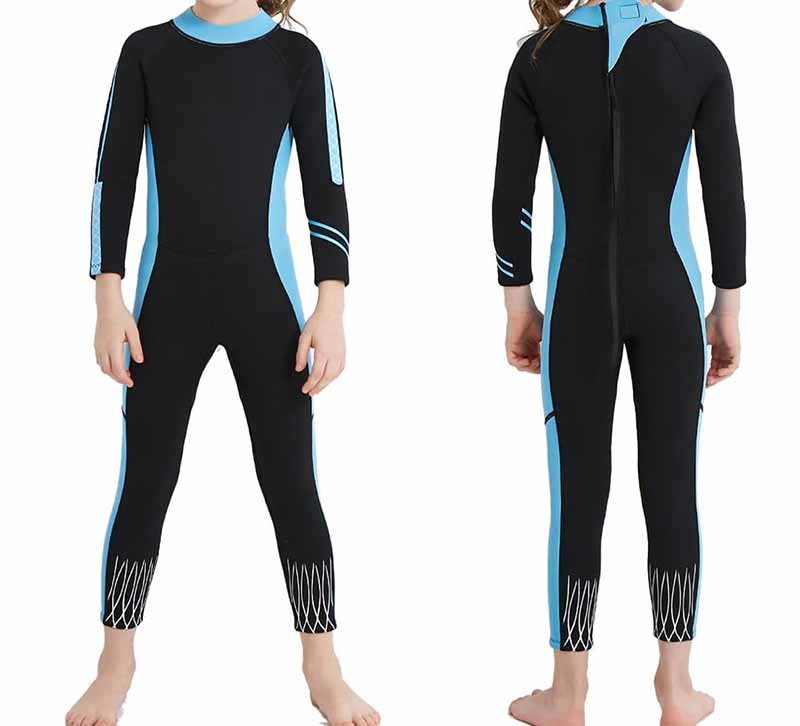
Most kids’ wetsuits are made of neoprene — a flexible, closed-cell foam that traps air and water for insulation. The best models use eco-limestone neoprene, which is softer, more durable, and environmentally friendly. Linings like nylon or polyester add comfort, while glued or blind-stitched seams prevent leaks and irritation. Together, these materials make wetsuits buoyant, flexible, and warm — perfect for growing swimmers.
1. Why Neoprene Is the Standard
Neoprene remains unmatched for insulation, flexibility, and buoyancy. Its closed-cell structure traps air inside tiny bubbles, reducing heat loss and helping kids float more easily.
Unlike spandex or lycra, neoprene doesn’t absorb water — it resists it. This creates a lightweight, warm, and long-lasting wetsuit suitable for both beginners and pros.
2. Eco-Limestone Neoprene — The Modern Upgrade
Traditional neoprene was made from petroleum-based rubber. Many modern manufacturers, including Szoneier, now use eco-limestone neoprene, derived from natural limestone minerals instead of crude oil.
Benefits include:
- Lower carbon emissions during production.
- Improved softness and elasticity.
- Longer lifespan and UV resistance.
- Reduced odor and better comfort for sensitive skin.
Parents increasingly prefer limestone neoprene for kids’ gear — it’s safer, greener, and lasts longer.
3. Lining Materials for Comfort
Neoprene by itself can feel slightly rubbery, so it’s laminated with soft inner and outer linings:
- Nylon lining: Common for flexibility and softness.
- Polyester or jersey lining: Quick-drying and abrasion-resistant.
- Thermal fleece lining: Used in cold-water wetsuits for added warmth.
These layers also make it easier to slide the wetsuit on and off — a lifesaver for parents managing wiggly toddlers.
4. Seams and Stitching — The Hidden Details
Seam technology greatly affects warmth and durability.
| Stitch Type | Warmth Level | Flexibility | Water Resistance |
|---|---|---|---|
| Flatlock | Medium | High | Moderate |
| Glued & Blind Stitched (GBS) | High | Medium | Excellent |
| Taped Seams | Highest | Medium | Fully waterproof |
Szoneier’s kids’ wetsuits often use GBS with double reinforcement — balancing warmth and mobility without sacrificing comfort.
5. Special Add-Ons
- Smooth-skin panels: Block wind and reduce evaporation.
- Reinforced knees/elbows: Ideal for active children.
- UV-resistant coatings: Extend fabric life under strong sunlight.
These small details distinguish low-cost mass-market suits from professional-grade wetsuits built for comfort and longevity.
Which Wetsuit Thickness Is Right for Children?
The ideal wetsuit thickness for kids depends on water temperature and activity level. A 2mm shorty works for warm indoor or tropical swimming, 3mm–4mm full suits fit moderate coastal or surf conditions, and 5mm wetsuits are best for cold or long outdoor sessions. The thicker the neoprene, the better the warmth—but flexibility decreases slightly, so balancing comfort and insulation is key for growing swimmers.
1. Understanding Wetsuit Thickness
Wetsuits are measured in millimeters (mm), and a label like “3/2mm” means the torso neoprene is 3mm thick while the arms and legs use 2mm for easier movement.
For kids, it’s not just about temperature—it’s about keeping them warm without tiring them out.
- 2mm (Shorty Suit): Lightweight, flexible, and perfect for summer or pool use.
- 3mm: Balanced insulation for mild coastal waters or spring surfing.
- 4–5mm: Maximum warmth for open water, diving, or cold climates.
A thicker wetsuit keeps warmth longer but may restrict mobility; for active kids, flexibility matters as much as insulation.
2. Water Temperature vs Thickness Chart (Children’s Guide)
| Water Temperature (°C/°F) | Recommended Wetsuit | Thickness (mm) | Type |
|---|---|---|---|
| 26°C+ / 79°F+ | Optional, for UV protection | 1.5–2mm | Shorty |
| 22–25°C / 72–77°F | Standard swimming & surf | 2–3mm | Shorty or Full |
| 17–21°C / 63–70°F | Mild cold coastal water | 3–4mm | Full Suit |
| 12–16°C / 54–61°F | Cool or northern climates | 4–5mm | Full Suit |
| Below 12°C / 54°F | Cold water diving | 5mm+ | Full Suit with hood |
3. Mobility vs. Warmth
Parents often ask: “Should I buy thicker for extra protection?”
Not always. Children are more sensitive to stiffness — if the suit is too thick, they’ll feel restricted and may lose enthusiasm.
A 3mm full-body wetsuit usually provides the best all-around balance for kids aged 5–12 who swim or surf in moderate conditions. For toddlers, flexibility and ease of dressing should always take priority.
4. Suit Type by Activity
Different sports demand different designs.
| Activity | Best Thickness | Wetsuit Type | Notes |
|---|---|---|---|
| Indoor swimming | 1.5–2mm | Shorty | Easy to wear, UV cover |
| Surfing/snorkeling | 3mm | Full suit | Core warmth + arm flexibility |
| Open water/swim training | 3/2mm or 4mm | Full suit | Reduces fatigue |
| Diving/long exposure | 5mm | Full suit + hood | Retains body heat best |
A wetsuit isn’t just about keeping warm — it’s about ensuring consistent body performance over time.
5. Seasonal and Growth Considerations
Kids grow fast, so sizing up slightly is common. However, don’t compromise on fit — gaps reduce warmth and buoyancy. If your child swims year-round, consider having two wetsuits:
- A thinner one for summer and indoor pools.
- A thicker one for fall/winter or outdoor use.
Szoneier supports custom size adjustments, allowing manufacturers, brands, or retailers to tailor fit ranges precisely for child age groups or regional markets.
How to Choose the Right Size and Fit for a Kids’ Wetsuit
Measure your child’s chest, waist, and height to select the right wetsuit size. It should fit snugly but not feel tight or restrict breathing. Avoid wrinkles or loose spots, as water will pool there and reduce warmth. Always check for easy zipper access and stretch comfort around the shoulders and knees. A well-fitted wetsuit should feel like a second skin when dry.
1. The Perfect Fit Checklist
A correctly sized wetsuit ensures warmth, mobility, and safety.
It should:
- Fit snugly with no air gaps or loose folds.
- Allow natural arm and leg movement.
- Be easy to zip but not overly tight around the neck.
Remember: a wetsuit should feel tight when dry — it loosens slightly once wet.
2. How to Measure Your Child
You’ll need a soft measuring tape to take three key measurements:
- Chest Girth: Around the widest part of the chest.
- Waist: Around the narrowest point of the torso.
- Height: From shoulder to ankle for full suits.
| Child Size | Height (cm) | Chest (cm) | Weight (kg) | Recommended Wetsuit Type |
|---|---|---|---|---|
| XS / Toddler (2–4 yrs) | 90–110 | 50–55 | 12–18 | 2mm shorty |
| S (5–6 yrs) | 111–125 | 56–60 | 18–24 | 2–3mm full suit |
| M (7–9 yrs) | 126–140 | 61–66 | 25–32 | 3mm full suit |
| L (10–12 yrs) | 141–155 | 67–74 | 33–45 | 3/2mm or 4mm full suit |
Always try the wetsuit before purchase if possible, or consult custom fitting options from your manufacturer.
3. Neck and Shoulder Fit
This is where many parents go wrong — if the neck is too tight, it can cause irritation or limit breathing.
A tapered, soft collar edge with Velcro or glide-skin lining helps prevent chafing. Similarly, raglan sleeve designs allow full paddling motion without pulling on the shoulders.
4. Zip Placement
- Back zip: Easiest for kids to put on/off; ideal for beginners.
- Chest zip: Better flexibility and water seal; used in advanced suits.
- Front short zip: Found in toddler shorties for easy wear.
Szoneier offers all zipper placements with YKK® rust-resistant zips for durability and safety.
5. Tips from Experts
- Always test movement — ask your child to squat and lift arms overhead.
- If water pools at the lower back, size down.
- If the suit leaves red marks after 5–10 minutes, size up.
A properly fitted wetsuit doesn’t just keep your child warm — it keeps them happy and confident in the water.
Are Kids’ Wetsuits Safe and Comfortable?

Yes — kids’ wetsuits are safe and comfortable when made from high-quality neoprene and fitted correctly. They protect against cold, UV rays, abrasions, and stings while helping children float more easily. Comfort depends on proper fit, seam design, and material softness. Modern wetsuits use eco-friendly neoprene and flatlock stitching, making them soft, stretchy, and irritation-free — perfect for sensitive young skin.
1. Softness and Flexibility
Children’s skin is more delicate than adults’, which is why the texture and stretch of neoprene matter. Premium-grade neoprene, such as limestone-based CR neoprene, offers smoothness and 200% stretch — allowing natural motion while swimming or paddling.
Szoneier’s factory-grade neoprene is tested for tensile strength and compression set, ensuring the suit bends easily but never loses shape after repeated use.
Comfort starts from the inside — the lining material, not just the outer shell.
2. Breathable Linings and Anti-Chafe Design
Neoprene suits for kids often include soft nylon jersey linings or thermal fleece for extra comfort. Flatlock seams prevent rubbing, while glued seams minimize leaks.
Key comfort features:
- No internal tags or rough stitches.
- Quick-dry lining that prevents rashes.
- Glide-skin collars for neck comfort.
- Flexible cuffs to avoid tightness around wrists and ankles.
Parents who tried Szoneier’s prototypes during testing reported their kids stayed comfortable for over two hours of continuous swimming with no complaints of “itchiness” or “tightness.”
3. Safety Through Smart Buoyancy
Wetsuits aren’t life jackets, but they naturally support buoyancy — especially for kids under 40kg. This added flotation helps maintain balance and confidence.
For open water or surf, a 3–4mm neoprene full suit keeps a child naturally afloat, making it easier to rest or tread water if needed.
That little extra lift can make a huge difference in fatigue and safety, especially for beginners.
4. UV and Wind Protection
Neoprene blocks 95% of UV rays, shielding the skin better than sunscreen. Smooth-skin panels also block wind chill after exiting the water — a small detail that prevents post-swim colds.
Szoneier integrates UV-tested neoprene with reflective print patterns for added style and protection — a feature now popular among surf schools and family beach brands.
5. Tested for Real-World Safety
Every Szoneier kids’ wetsuit undergoes:
- Stretch and compression tests.
- Colorfastness and UV resistance checks.
- Seam stress evaluation.
- Non-toxic glue certification.
This ensures each batch meets international child safety standards (REACH, CPSIA) and performs reliably across climates and swim conditions.
How to Care for and Maintain a Kids’ Wetsuit

Rinse the wetsuit with cool, fresh water after every use to remove salt, chlorine, and sand. Avoid wringing or using heat to dry; hang it flat in shade. Use mild soap if needed, and store flat or on a wide hanger to prevent creases. With proper care, a neoprene wetsuit lasts 2–3 years or longer without losing flexibility or buoyancy.
1. Rinse Immediately After Use
Salt, sand, and chlorine can slowly degrade neoprene. After every swim or surf session:
- Turn the wetsuit inside out.
- Rinse with cool or lukewarm fresh water.
- Gently squeeze out water — don’t twist or wring.
This prevents salt crystals from stiffening the fabric or damaging seams.
2. Dry Naturally
Air drying is crucial. Hang the wetsuit in shade using a wide plastic hanger (metal hangers can rust). Avoid sunlight and high heat — they cause cracking and loss of elasticity.
Tip: Dry the inside first, then flip it after 6–8 hours for even drying.
3. Store Properly
Lay the wetsuit flat or hang it from the waist to prevent stretching. Store it in a cool, dry area. If storing for months, sprinkle a bit of baking soda to absorb odor and moisture.
A well-stored wetsuit can maintain 95% of its flexibility even after two years.
4. Cleaning and Odor Control
Use a neoprene-safe shampoo or mild baby soap once a month. Avoid bleach or detergent.
For odor control:
- Add 1 tablespoon of white vinegar per gallon of rinse water.
- Rinse thoroughly to remove residue.
5. Repair Small Tears Early
Tiny cuts or seam splits can be fixed with neoprene cement or patch glue. Szoneier offers OEM repair kits and instruction inserts for retailers or brand partners — a simple way to extend product lifespan and build customer trust.
Conclusion — Why Choose a Custom Kids’ Wetsuit from Szoneier
After exploring what wetsuits do, how they work, and why they matter, one truth stands out:
A well-made neoprene wetsuit transforms a child’s water experience — from shivering to smiling, from anxious to confident.
Parents love the peace of mind, and brands love the quality difference that expert manufacturing delivers. That’s where Szoneier shines.
Why Partner with Szoneier
With over 18 years of professional neoprene R&D and manufacturing experience, Szoneier is one of China’s most trusted suppliers for kids’ wetsuits and related neoprene products.
Our strengths:
- OEM & ODM service: custom logo, size, color, or pattern.
- Free design, fast sampling, and low MOQ.
- Eco-limestone neoprene materials for better performance and sustainability.
- Short production lead times and strict QC inspection.
- Support for small brands and premium retailers.
From toddler wetsuits to teen surf gear, we help brands create safe, stylish, and durable waterwear that kids love — and parents trust.

